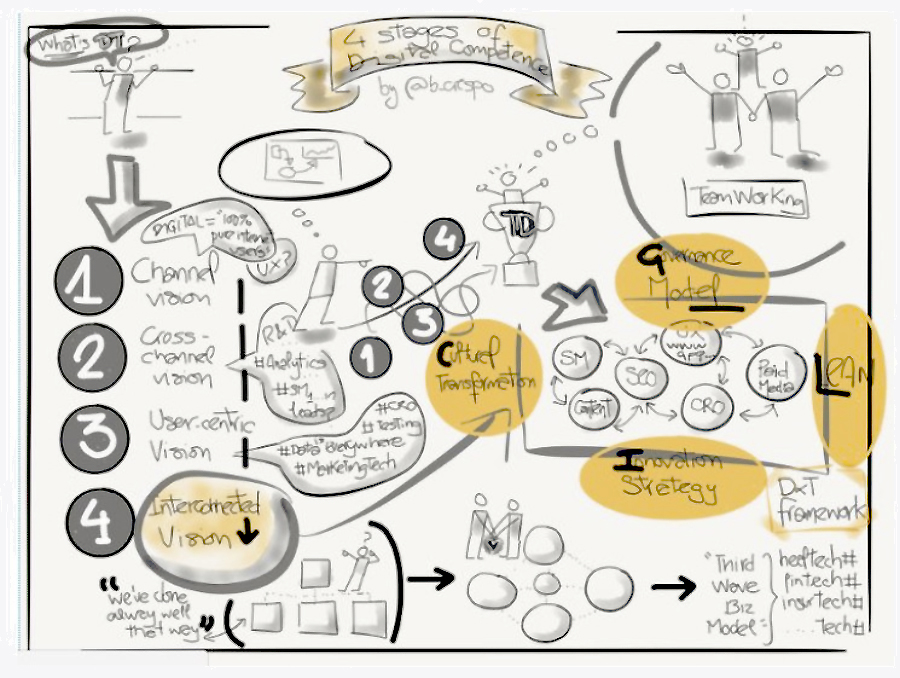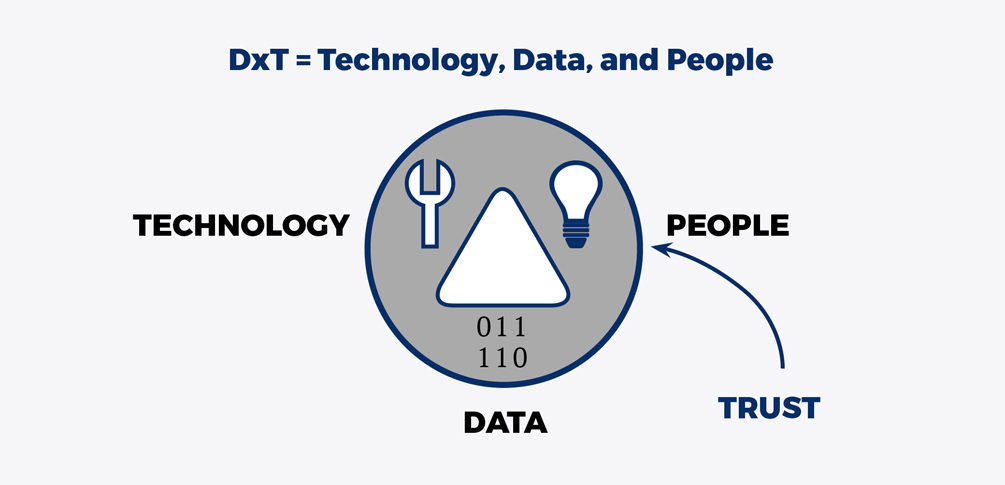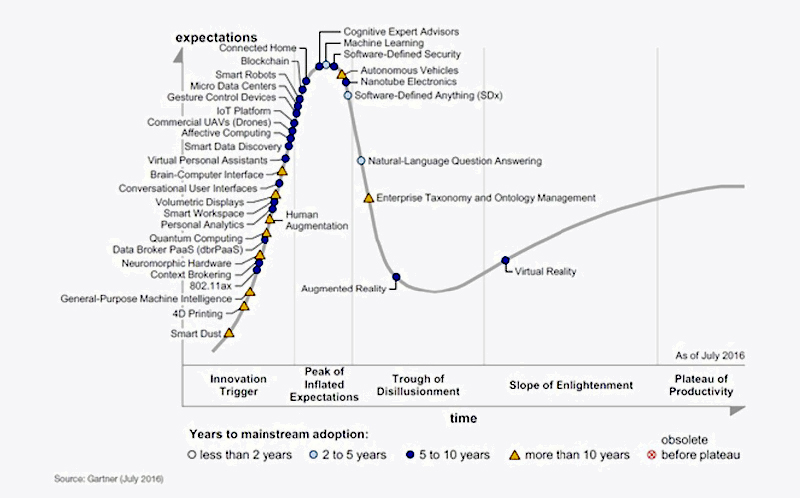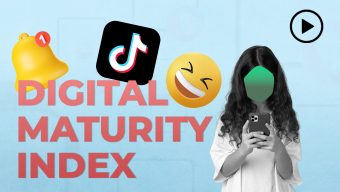Digital transformation is a strategic challenge in which culture plays a decisive role and trust is the key ingredient. The goal is to maximize the value of technology, data, and people. But how are organizations integrating this change?
Four Stages of Digital Competence
In my view, the integration of new competences at the organizational level can be divided into four stages, similar to the four stages of learning a new skill or ability or the stages of digital evolution at organizations (source: Bernardo Crespo, “Four Stages of Competence in Digital Strategy”):
- Channel vision: unconscious incompetence. Companies try to manage a single distribution model through different channels. The channels become an alternative to distribution efficiency. In this initial stage, each channel wages its own war, often giving rise to a certain degree of competition between the traditional channel and the digital one. From a user perspective, such internal dysfunction makes no sense, as it is taking place within the same brand experience. These organizations have interpreted digital transformation as an exercise in efficiency affecting the thickest part of their income statement.
- Cross-channel vision: conscious incompetence. Companies begin to accept that digital is more than just a multi-channel user experience and that technology can facilitate and enhance multiple parts of the distribution model or value chain. They begin to discover that you really can combine optimization of digital at the traditional business model level with other more radical or disruptive innovation possibilities. They begin to exploit and explore: exploit the current business model by boosting profits while at the same time exploring new business models with a view to injecting future profitability.
- User-centric vision: conscious competence. Those companies that already view each and every interaction with users as something that can be measured have come to understand that technology is a facilitator, but that the true lever of digital transformation is people. As a result of their maturity with regard to the use of technology and the optimization of data-traceability possibilities, they know that certain skills and abilities will generate differentiation in the future. They have discovered that the company’s culture is one of the most powerful levers of change.
- Interconnected vision: unconscious competence. In this final stage, companies have successfully evolved their business model; technology and data are strategy facilitators. They have developed the best way to accelerate the transformation of culture into processes and new forms of relationships between professionals. Traditional skills and new ones are no longer a source of friction. In this last stage, companies know which technology to incorporate based on their specific needs as opposed to the latest hype. Each company is able to translate technology to needs based on a roadmap. Among other things, this is because they have already determined where they wish to go with their digital transformation, rather than simply reacting to the transformation or to digital itself.

A Possible Solution: Technology, Data, and People
Is there a way to break down the challenge of digital transformation?
Digital transformation simply means maximizing the value of technology, data, and people. The key ingredient in that maximization is trust.
Trust at various levels
Trust between people who share a strategic space and unique vision – at a company of silos, there is no room for trust. Trust by people in technology, both in general and as a facilitator of vision and strategy. Trust in the traceability of all information (data) in this new context. All of this trust depends on striking the right balance between the use of data to build value and the risk that using it poses to security. We live in an environment in which technology has facilitated the offshoring of data and in which software, platforms, and infrastructures as services (SaaS, PaaS, and IaaS) allow us to take a longer path to efficiency and effectiveness. However, the security of the data we keep in the cloud leaves us more and more vulnerable. Everything is a delicate balancing act in an increasingly less local environment.

In this context and with regard to trust from the perspective of data, does it make sense to legislate based on a regional vision in a world of offshore technology and data management? The European Union is determined to pass laws that promote consumer protection and has just laid the foundations for data use in the Digital Media Age in Europe, to take effect in May 2018 (Johnny Ryan, “Europe’s new privacy regime will disrupt the adtech Lumascape”). No one knows what will happen in the coming years, but for now Europe will be competing in unequal conditions with other parts of the world, such as the United States or Asia. The new legislation on the protection and movement of data in the EU (General Data Protection Regulation or GDPR), which replaces Directive 95/46/EC on data protection, positions Europe as the region of the world in which users will be most strongly protected, and digital development by companies most limited, due to restrictions on the use of third-party data.
Given that, in the digital age, the use of the information and data provided by technology is a catalyst for change, why would European regulators seek to weaken an entire industry compared to other regions of the world for the sole purpose of satisfying the demands of users and the most bullheaded lawyers? Is it at all logical to require the company that owns a digital asset such as a webpage to have to show users, midway through their browsing experience and in real time, that it has each and every one of the necessary authorizations to use their data? Should we round out the 768 pixels with a legal disclaimer? Who benefits from this regulatory exercise? Data is one of the levers with the greatest multiplier effects in digital transformation. It allows us to learn, optimize, and even create new business models and generate value for an economy. In my view, it is more logical to design a legal framework that encourages harmonization and allows competition to drive the capacity to innovate as a lever of differentiation. We are once again witnessing a scenario like that of the transposition of the so-called Cookies Directive, under the guise of guaranteeing trust. Or are we not perhaps talking about regulating mistrust?
Leadership of the digital change is a question of people and skills; technology may be more necessary than ever, but alone it is not enough. Strategy is even more important, and it is the CEO who must lead the transition.
Technology Is Evolving at a Spectacular Pace
We are all familiar with concepts like “big data” or “augmented reality,” concepts that are quickly being left behind and giving way to new, unpronounceable technologies. This very year, in 2017, we may witness the consolidation of the use of data and technologies, of chat bots and technologies such as 3D printing. And although every year Gartner publishes its “Hype Cycle for Emerging Technologies” and new technologies burst on scene, all professionals must decide, based on their knowledge of their specific vertical, on their specific strategic capabilities and creative and executive skills with regard to innovation, which technologies will actually help them achieve their strategic goals.

In Addition to Data and Technology, There Are People
Although today it is possible to generate intelligent systems (artificial intelligence) with an amazing capacity to learn and evolve, we have not yet managed to build a system able to replicate human intuition. Our creative capacity, our intuition, and our passion will continue to be what greases the wheels of any transformation process. And it is impossible for an organization to change strategy when its culture is dragging it toward a space of non-collaboration. Again, trust can block and/or catalyze the “people” axis of the digital transformation equation.
The future transition requires a new culture in which testing and learning needs to be part of each and every employee’s DNA. Leadership of the digital change is a question of people and skills; technology may be more necessary than ever, but alone it is not enough. Strategy is even more important, and it is the CEO who must lead the transition. Who else to lay down a vision and surround him or herself with the necessary talent to achieve the desired future situation? Companies that have accepted the possibility of making mistakes are the best prepared to manage change. Those corporations that have not yet spent time determining a course, a purpose – no matter how threatening it may be to try to chart that course in today’s VUCA environment – are unlikely to succeed in a process of digital transformation.
The future transition requires a new culture in which testing and learning needs to be part of each and every employee’s DNA.
Above all, digital transformation is a strategic challenge in which culture plays a decisive role. And, although, as Peter Drucker said, organizational culture eats strategy for breakfast, the reason digital transformation is on the agenda of CEOs and governments alike is due to the economic and social value the challenge harbors. The World Economic Forum’s Digital Transformation Initiative (“Introducing value at stake: a new analytical tool for understanding digitalization”) has estimated the value of digital transformation for four industries at more than 23 trillion dollars for the next ten years. There are more than enough reasons when value creation is at stake. And this value creation lies as much in the growing business for industries as in the value generated for consumers and society at large.
According to the 2017 Divisadero-IE Barometer, which studies the digital maturity of Spanish companies, 74% of Spanish corporations have begun a process of digital transformation, and 57% have incorporated senior digital executives. This is not a trend. It is a fact. Knowing how to determine which levers drive the digital challenge and transform how we compete is the key issue facing most major corporations in all the world’s verticals. In the Divisadero-IE report on digital maturity, the vectors leading to digital transformation were as follows:
- Organizational and business model.
- Innovation management and data-driven maturity.
- Cultural transformation and digital capabilities.
The challenge of how to generate value combining the best of technology, data, and people is the equation to solve to achieve the desired differentiation in any industry right now. Tomorrow, digital will be a mere footnote, and the transformation will already have taken place.
© IE Insights.











